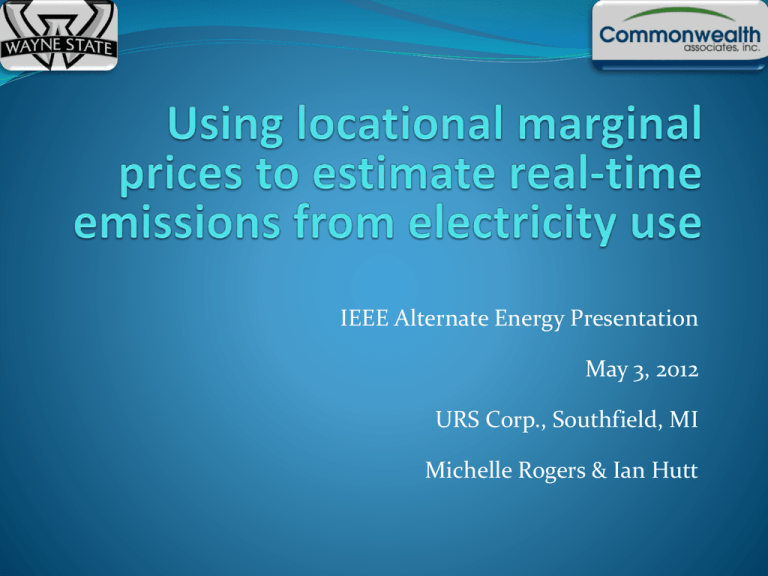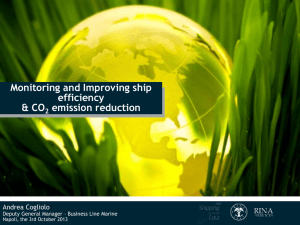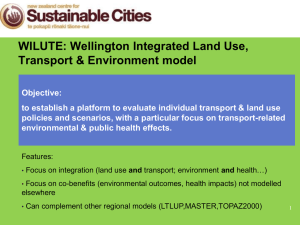IEEE Alt Energy 05-03-2012 Presentation
advertisement

IEEE Alternate Energy Presentation May 3, 2012 URS Corp., Southfield, MI Michelle Rogers & Ian Hutt Team Background Michelle Rogers Master’s student at Wayne State studying Civil & Environmental Engineering B.S. Chemical Engineering from Michigan State Ian Hutt Electric Engineer at Commonwealth Associates, Inc Expertise in electrical power systems & power marketing Team Background Other Team Members: Wayne State: Dr. Carol Miller, Dr. Caisheng Wang, Dr. McElmurry, Tim Carter Commonwealth Associates: Stephen Miller TYJT: Awni Qaqish, Steve Jin, Carrie Smalley Outline Introduction to the project How project was started Purposes of development How it works LMP Marginal Generating Unit Emissions Application for water distribution systems Wider applications: household electricity use HERO smartphone App Introduction Algorithm estimates real-time emissions based on locational marginal price (LMP) Started as a project for sustainable water delivery Also has wider implications / uses Why was this project started? GLPF, Great Lakes Protection Fund grant Grant title: “Real-Time System Optimization for Sustainable Water Transmission and Distribution” Purpose: minimize environmental impacts to the Great Lakes Optimize energy use in water system distribution (pumping) Why was this project started? GLPF, Great Lakes Protection Fund grant Became clear that emissions, not just energy use, was the key in minimizing environmental impact Not all energy use is equal (from emissions standpoint) Emissions vary with type of generation fuel Depends on time and location Applications Not all energy use is equal (from emissions standpoint) Any power user that has ability to vary timing of energy use could save emissions Timing does not affect economics, but could still affect emissions Industrial or commercial users that have storage capacity (like compressed air or pumps) Methodology Use LMP to predict the marginal fuel type Calculate emissions associated with that fuel type for a specific area Locational Marginal Prices LMPs available from MISO (Midwest Independent System Operator) LMPs for select Commercial Pricing Nodes (CPNs) available every 5 minutes Locational Marginal Prices LMPs based on marginal cost of supplying the next increment of electric demand at a specific location LMP Accounts for: generation marginal cost (fuel cost) physical aspects of transmission system (constraint in transmission lines) Cost of marginal power losses Locational Marginal Prices Locational Marginal Prices Locational Marginal Prices Key Assumptions: Any change in electricity use is small enough to not affect generation mix LMP cost takes into account electrical transmission constraint Model predicts the marginal unit type Locational Marginal Prices LMP Accounts for: physical aspects of transmission system (constraint in transmission lines) Within a small focus area, can assume constraint in the physical transmission system = ~ zero Cost of marginal power losses Assume marginal power losses = ~ zero Generation marginal cost (fuel cost) Left with LMP = ~ fuel cost Locational Marginal Prices Price ($/MWh) LMP = ~ fuel cost LMP at time ti Hydro & Nuclear Coal Natural Gas Oil Fuel Prices LMP = ~fuel cost Find fuel price data (EIA – public sources) Heat Rate (efficiency) of each plant: Weighted average of monthly fuel price calculated from plant fuel purchases Cost of electric generation computed: Fuel Prices Get price ranges for Fuel types For Example: DTE Power plants in SE Michigan Marginal Fuel Type Min LMP Max LMP Nuclear/Renewable < $10 $10 Coal $10 $50 Nat. Gas & RFO $50 $180 Dist. Fuel Oil $180 > $180 LMP Marginal Generator Type Air Emissions Emission Rates LMP Marginal Generator Type Air Emissions Measured Air Emissions Data from EPA’s eGRID (Emissions & Generation Resource Integrated Database) Data on thousands of power plants in the US Sort by EGCL code (Electric Generating Company, Location-Based) i.e., all of DTE-operated plants in SE Michigan Emission Rates Calculate average emission rate for entire area for each fuel type Example, Detroit Edison: (2008 data) Air Emissions in pounds pollutant per MWhr generated (lb/MWh) Pollutant Nuclear Coal Natural Gas Distilled Fuel Oil SO2 0 10.54 1.65 2.3445 NOX 0 3.05 1.57 21.73 CO2 equiv 0 2071 2292 1862 Hg 0 5.26E-05 3.62E-06 5.81E-06 Pb 1.09E-07 3.10E-05 1.66E-06 3.65E-05 LMP Marginal Generator Type Air Emissions Application for water distribution systems GLPF Grant: “Real-Time System Optimization for Sustainable Water Transmission and Distribution” Emissions estimation algorithm used in optimization program for pumping stations. Two pilot water systems: Hydraulic Model Use EPANet hydraulic models Input: Pipe length Pipe diameter Demand at each node Diurnal demand pattern Pump power Pump efficiency curves Elevation Tanks and reservoirs Hydraulic Model City of Monroe Hydraulic Model DWSD Sustainable Water Transmission Need to combine: Hydraulic Model + Emissions Estimation Model PEPSO: Pollutant Emissions Pump Station Optimization Uses hydraulic model to output optimized pumping schedule Optimization based on: Emissions Energy Cost Pressure constraints in system PEPSO Input: Load Hydraulic Model PEPSO Input: Load Pressure Monitoring Nodes PEPSO Input: Select Commercial Pricing Nodes (CPNs) PEPSO Input: Select Pollutants of Interest PEPSO Output Energy use per hour for each pump station. Pounds of pollutant emissions per hour for optimized operation of each pump station. Pressure violations, if any. PEPSO Output Sustainable Water Transmission PEPSO will be used to evaluate many scenarios High/low demand Different pollutants Availability of raised storage Optimization based on cost vs. emissions Use as a tool to make policy and operational recommendations Reaching a broader audience: the HERO app HERO = Home Emissions Read-Out (LMP Marginal Generator Type Air Emissions) Applying this concept to household energy use App for smart phones HERO Uses location to determine marginal emissions in real-time Knowledge of current emissions empowers consumers to reduce emissions just by changing the timing of electricity use HERO Input HERO can automatically find nearest CPN based on phone’s GPS User also has choice to pick location from map HERO Output Current, Past, and Projected Future emissions CO2, NOX, SOX, Mercury, Lead HERO Output User can view more to see background information on CO2, NOX, SOX, Mercury, Lead Environmental Effects, Human Health Effects Example: NOX & SOX HERO Status Still under development Preliminary version should be finished in Fall After small test audience makes recommendations, fix all bugs, then beta version release in Google Play App Store Questions?







